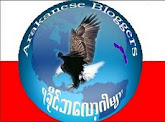The Mahamuni shrine is situated north latitude 21'^ east longitude 0-5"^ 8 miles ^^st Qf the
Kaladan river and 48 miles north of Mrohaung, the once famous capital cf the Arakanese kinffS.
History. — The earliest dawn of the history of Arakan reveals the base of the hills, which
divide the lower course of the Kaladan and L^mro rivers, inhabited by sojourners from India
governed by chiefs who claim relationship with the rulers of Kapilavastu. Their subjects are divided
into the four castes of the older Hindu communities; the kings and priests study the three Vedas •
the rivers, hills, and cities bear names of Aryan origin; and the titles assumed by the king and
queen regnant suggest connection with the Solar and Lunar dynasties of India.
The Lfemro river was then called Anjanadi, from its crooked course. MSrayu the first of
Arakanese kings, founded the city of Uhanj'avati on the banks of the Slrimanadi (now the Xhare
creek). The ICaladan meandered past the S'lilagiri (now Kyauktaw) under the appellation Gaccha-.
bhanadi and joined the sea (samudra) below Urasa, the present Urittaung. The Mallapabbata
Gandhagiri, and J5rupabbata separated the Kaladan from the Mallayunadl (Mayu river), and to the
west rose the Kasinapabbata. Later on, but still before our era, four towns (chaturgSrrta) were
founded where the Launggyet creek joins the Lemro ; the modem villager Nankya, Barin, Bato, and
L*'tma indicate the sites of the "four cities;" and the Aftjanadi changed its nailie '^o L^mro (Le-
Tiyomyit), or the " four-city river." Vaijali (Vesali) is said to have first been founded by King
Vasudeva. The ruins of this town can still be traced ^amiles north of Mrohaung, 2 mileseast of
the village of Paragyi. Both Dhanyavat! and Vesali were repeatedly destroyed by neighbouring
mountain tribes, but again rebuilt by the Aryan settlers.
With Candrasuriyaor Mahacandrasuriya appear the dim outlines of the history cf A.*akan. This
monarch erected a new city and palace on the site of Old Dhanyavat! ; to this ruler historical annals
and traditions unanimously ascribe the foundation of the original Mahamuni shrine intended to receive
the brazen image of Gotama. The records cf Farther India make Candrasuriya a contemporary of
Mahamuni, the great sage. Buddhism, as it now prevails in Burma, is decidedly an offshoot of the
Southern Buddhist school. In the i ith and 1 2th centuries the priests of Pagan united their church
^-ith the mother-church of Ceylon. In the loth century Buddhism, established in Burma by Sona and
Uttara who were sent by Asoka, must have become nearly extinct. Manuha, King of the Talaings,
■was brought captive to Pagan by Anawratha doLh'centurvl ; he was, however, allowed to build a
residence for himself, and in this palace nearly all Is Indian art, and Tric"j.''t';';rsig"S'' supreme, as is
evident fran the stone sculptures still preserved in the edifice (see Report on Pagan). , The religious
zeal of Anawratha and Kara pat ijayasura again secured supremacy to Buddhism. But there are old
Buddhist traditions among the Talaings and Arakanese, traditions which could not have originated
with the Southern Buddhist school, but are the remnants of the old Northern Buddhism, which reached
Arakan from the Ganges when India was mainly Buddhistic ; they form a substratum cropping up here
and there apparently without any connection ; its centre is the Mahamuni pagoda, the most Important
remains 'of ancient Buddhism in Burma, antedating in this province both Brahmanism and the
Buddhism of the Southern school. The legend asserts that during the reign of Candrasuriya, King
of Dhannavati (Morthem Arakan), Gotama Buddha came with many of his followers to this count"y.'
...................
Read Full Text "Arakan-Forchhammer-1891"
Read Online.
Download PDF.
5 years ago










0 comments:
Post a Comment